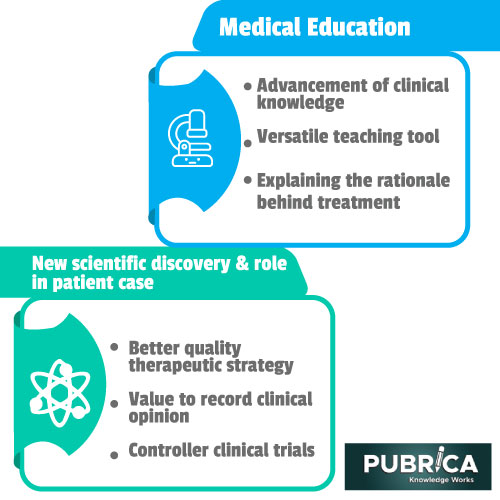
Structure of a medical paper writing: essential elements and reporting guidelines
February 19, 2021
A practical Guide to do Primary research on Meta analysis Methodology
February 26, 2021In-Brief
- Medical case study report writing should encompass the following five sections: an abstract, an introduction with a literature review, a description of the case report, a discussion that includes a detailed explanation of the literature review, and a summary of the case and a conclusion.
- All biomedical research offers some sort of data that can be used to guide patient care. The gathered data or research evidence’s strength and quality are mainly based on the clinical research design type.
Introduction
Randomized clinical trials act as a cornerstone in advancing medical literature. They are labour intensive, expensive, and need significant resource utilization. In addition to that, they are often challenging to execute. Deals with unusual diseases, which are caused due to a lack of significant study, i.e. group sizes. The major benefit in the publication of case reports is its essential role in medical education. Regardless of experience, whether they are a first-year medical student or an expert physician, case reports have a significant role in advancing clinical knowledge. It acts as a versatile teaching tool.
General Principles of Case Report
Medical case study report writing is a research design that describes unexpected or novel clinical course occurrence, report of findings and prognosis of an individual patient, which might be or but not compulsory, accompanied by a review of the literature of other reported cases. Though they are considered the bottommost in the hierarchy of evidence-based practice in the medical literature, it offers necessary data for shared individual experiences and unfamiliar events to improve understanding and optimise patient care. This method might produce an idea or hypothesis. It will not be confirmed unless conducting additional observational study designs or confirmatory quantitative experimental such as clinical trials or cohort studies. Apart from that, a case report offers the medical community evidence that any other designs cannot pick up. The clinical observation case report might be in the tail of the hierarchy of evidence-based medicine. Still, if properly selected and appropriately reported, it might stand a better chance of publication in high impact journals than even a clinical trial.
Clinical study design and the value of case reports and studies in evidence-based practice
All biomedical research offers some sort of data that can be used to guide patient care. The gathered data or research evidence’s strength and quality are mainly based on the research design type. Clinical research design comprises the following 3 types of studies such as,
- Case reports and studies,
- Observational clinical research, and
- Experimental clinical research
In that observational research, the methodology comprises the case-control study, the cohort study, and the cross-sectional study.
Experimental clinical research design includes a Randomized Controlled Trial (RCT), which is also called a double-blind, randomized controlled trial when carried out in a double-blind manner. Case reports can be informative at times, but it has some restrictions due to the low strength of evidence that they provide. The low strength of evidence which is offered by case reports and readings got from multiple intrinsic characteristics of such studies contains
- Absence of appropriate controls;
- Restricted sample size (one to a few individuals); and
- Lack of blinding. All these fundamental characteristics bring about important bias and random errors.
Because of the above restrictions, analysis of the results of case reports studies and examination of their consequences must be done with great caution. In contrast, in the hierarchy of evidence offered by the above three groups of clinical research design, the double-blind, randomized, placebo-controlled trial produce the strongest evidence for the efficiency and safety of a therapeutic modality or preventive. The strength of evidence is further improved by systematic review and meta-analysis of multiple randomized controlled trials. Case report writing services provides a clear view of clinical research and clinical studies.

Medical education
The major benefit in the publication of case reports is its essential role in medical education. Regardless of experience, whether they are a first-year medical student or an expert physician, case reports have a significant role in advancing clinical knowledge. It acts as a versatile teaching tool. It helps in stating two interrelated perspectives, both for patient and physician. It helps present a coherent story, reflecting the patient’s experience of illness and the physician’s diagnostic or therapeutic reasoning. A huge portion of knowing clinical medicine mainly depends on understanding a given sickness and its complexity of presentations. During their medical education, students have flooded with problem-based learning, clinical vignettes, etc. While these tools are significant in building and testing the basics of medical sciences, unusual cases, or novel treatments presented in case reports allow an additional expansive clinical knowledge base. At times clinicians and students were trained to evaluate numerous diseases based on a pattern of signs or symptoms. The evaluation of case reports in clinical literature permits clinicians and students to be aware of new or mixed presentation patterns. At the same time, teaching points explained in a case report often have noticeable longevity. Unless there is a huge change in the protocol caused due to diagnostic methods or recent therapeutics, the teaching points from a case report usually has no expiration date. Hence, many physicians and professors use previous cases for teaching purposes.
Finally, it is a standard in which medical students, experienced clinicians and recent graduates may record observations and thoughts in reaching a diagnosis or explain the rationale behind an innovative treatment.
New scientific discovery & role in patient care
As described above, one of the best features of the case report is it has the facility to report novel findings and better-quality therapeutic strategies. With quick, brief writing and publication rates, case studies are an essential tool for rapidly expanding the growing body of clinical knowledge. An example of this can be found while researching rare diseases or disorders. Running controlled trials with consistent testing procedures on rare disorders is very hard, as there are often insufficient patients to attain statistical power. Case studies present a venue to record opinions and possible therapeutic interventions that can be published.
A broad spectrum of data may be accessible in case reports such as unexpected complications, rare diseases from novel diagnostic or therapeutic techniques, standard therapy, and consequences from new technology, to name a few. These illustrations simultaneously upgrade clinical knowledge and create a platform for further questioning through controlled clinical trials. Thus, case studies also have a significant role in creating new research and hypotheses. The culmination of numerous case reports allows for comparison and generation of hypotheses for further testing.
It is significant to understand the impact case reports have had on patient care. For example, case reports regarding penicillin and toxic shock syndrome have had enhanced patient care and direct clinical impact after publication.
Conclusion
When assessing the significance of the case reports, it is essential to remember numerous things. First, it serves an essential role in the field of education. For example, the various presentations of a given disease explained in a case report function in enhancing clinicians’ knowledge at all levels. Irrespective of the publication date, conclusions drawn from these studies can generally be reestablished or reassessed, showing no true conclusion for these articles. Additionally, case reports provide a significant foundation for further research through comparison and reporting novel clinical phenomena. These comparisons have allowed for thought-provoking questions that have directly impacted medical protocols. Writing a medical case report is a long and complicated process to get help from online service providers.
References
- Li, Y. R., Jia, Z., & Zhu, H. (2013). Understanding the value of case reports and studies in the context of clinical research, research design, and evidence-based practice. Journal of Case Reports and Studies, 1(2).
- Ortega-Loubon, C., Culquichicón, C., & Correa, R. (2017). The importance of writing and publishing case reports during medical training. Cureus, 9(12).



